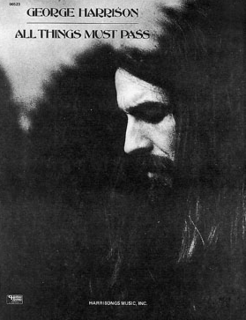
"All Things Must Pass" is a song by English rock musician George Harrison, issued in November 1970 as the title track to his triple album of the same name. Billy Preston released the song originally – as "All Things (Must) Pass" – on his Apple Records album Encouraging Words (1970) after the Beatles had rehearsed the song in January 1969 but overlooked it for inclusion on their Let It Be album. The composition reflects the influence of the Band's sound and communal music-making on Harrison, after he had spent time with the group in Woodstock, New York, in late 1968. In his lyrics, Harrison drew inspiration from Timothy Leary's poem "All Things Pass", a psychedelic adaptation of the Tao Te Ching.
"Far East Man" is a song written by English rock musicians George Harrison and Ronnie Wood, each of whom released a recording of the song in 1974. Wood's version appeared on I've Got My Own Album to Do, his debut solo album, and Harrison's on Dark Horse. Their only official songwriting collaboration, "Far East Man" is an affirmation of friendship in the face of life's obstacles and musically reflects the two guitarists' adoption of the soul genre. Written mostly by Harrison, the composition has been interpreted as a restatement of the humanitarian message expressed in his 1971 single "Bangla Desh", and a tribute to Indian musician Ravi Shankar.
"Sue Me, Sue You Blues" is a song written by English musician George Harrison, released on his 1973 album Living in the Material World. Harrison initially let American guitarist Jesse Ed Davis record it for the latter's Ululu album (1972), in gratitude to Davis for his participation in the Concert for Bangladesh. When writing the song, Harrison drew inspiration from the legal issues surrounding the Beatles during the early months of 1971, particularly the lawsuit that Paul McCartney initiated in an effort to dissolve the band's business partnership, Apple Corps.
"The Day the World Gets 'Round" is a song by English musician George Harrison, released on his 1973 album Living in the Material World. Harrison was inspired to write the song following the successful Concert for Bangladesh shows, which were held in New York on 1 August 1971 as a benefit for refugees from the country formerly known as East Pakistan. The lyrics reflect his disappointment that such a humanitarian aid project was necessary, given the abundance of resources available across the planet, and his belief that if all individuals were more spiritually aware, there would be no suffering in the world. Adding to Harrison's frustration while writing the song, the aid project became embroiled in financial problems, as commercial concerns delayed the release of the Concert for Bangladesh album, and government tax departments failed to embrace the goodwill inherent in the venture.
"Who Can See It" is a song by English musician George Harrison, released on his 1973 album Living in the Material World. The lyrics reflect Harrison's uneasy feelings towards the Beatles' legacy, three years after the group's break-up, and serve as his statement of independence from expectations raised by the band's unprecedented popularity. Some music critics and biographers suggest that he wrote the song during a period of personal anguish, following the acclaim he had received as a solo artist with the 1970 triple album All Things Must Pass and his 1971–72 Bangladesh aid project. The revelatory nature of the lyrics has encouraged comparisons between Living in the Material World and John Lennon's primal therapy-inspired 1970 release, Plastic Ono Band.
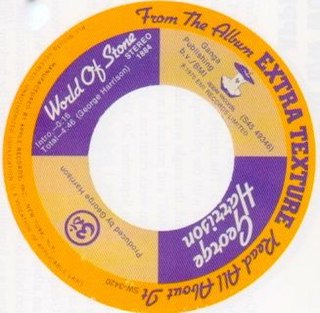
"World of Stone" is a song by English rock musician George Harrison, released in 1975 on Extra Texture , his final album for Apple Records. It was also issued as the B-side of the album's lead single, "You". Harrison wrote the song in 1973 but recorded it two years later, following the unfavourable critical reception afforded his 1974 North American tour with Ravi Shankar and the Dark Horse album. Due to its context on release, commentators view "World of Stone" as a plea from Harrison for tolerance from these detractors. According to some of his biographers, the lyrics reflect Harrison's doubts regarding his devotion to a spiritual path – an apparent crisis of faith that followed his often-unwelcome spiritual pronouncements during the tour, and which permeated his work throughout 1975.
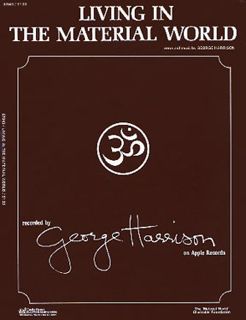
"Living in the Material World" is a song by English rock musician George Harrison that was released as the title track of his 1973 album. In the song's lyrics, Harrison contrasts the world of material concerns with his commitment to a spiritual path, and the conflict is further represented in the musical arrangement as the rock accompaniment alternates with sections of Indian sounds. Inspired by Gaudiya Vaishnava teacher A.C. Bhaktivedanta Swami Prabhupada, the song promotes the need to recognise the illusory nature of human existence and escape the constant cycle of reincarnation, and thereby attain moksha in the Hindu faith. The contrasts presented in "Living in the Material World" inspired the Last Supper-style photograph by Ken Marcus that appeared inside the album's gatefold cover, and also designer Tom Wilkes's incorporation of Krishna-related symbolism elsewhere in the packaging.

"Deep Blue" is a song by English rock musician George Harrison that was released as the B-side to his 1971 charity single "Bangla Desh". Harrison wrote the song in 1970, midway through the recording sessions for All Things Must Pass, and recorded it in Los Angeles the following year while organising the Concert for Bangladesh. The composition was inspired by the deteriorating condition of his mother, Louise, before she succumbed to cancer in July 1970, and by Harrison's feelings of helplessness as he visited her in hospital in the north of England. Given the subject matter, "Deep Blue" also served to convey the suffering endured by the millions of refugees from war-torn Bangladesh in 1971, as sickness and disease became widespread among their makeshift camps in northern India.

"Hari's on Tour (Express)" is an instrumental by English musician George Harrison, released as the opening track of his 1974 album Dark Horse. It was also the B-side of the album's second single – which was "Ding Dong, Ding Dong" in North America and most other territories, and "Dark Horse" in Britain and some European countries. Among Harrison's post-Beatles solo releases, the track is the first of only two genuine instrumentals he released from 1970 onwards – the other being the Grammy Award-winning "Marwa Blues", from his 2002 album Brainwashed.
"Simply Shady" is a song by English musician George Harrison that was released on his 1974 album Dark Horse. The song addresses Harrison's wayward behaviour during the final year of his marriage to Pattie Boyd, particularly the allure of temptations such as alcohol and drugs over spiritual goals. Harrison said the song was about "what happens to naughty boys in the music business".
"It Is 'He' " is a song by English musician George Harrison, released as the final track of his 1974 album Dark Horse. Harrison was inspired to write the song while in the Hindu holy city of Vrindavan, in northern India, with his friend Ravi Shankar. The composition originated on a day that Harrison describes in his autobiography as "my most fantastic experience", during which his party and their ascetic guide toured the city's temples. The song's choruses were adapted from the Sanskrit chant they sang before visiting Seva Kunj, a park dedicated to Krishna's childhood. The same pilgrimage to India led to Harrison staging Shankar's Music Festival from India in September 1974 and undertaking a joint North American tour with Shankar at the end of that year.
"See Yourself" is a song by English musician George Harrison, released on his 1976 album Thirty Three & 1/3. Harrison began writing the song in 1967, while he was a member of the Beatles, in response to the public outcry surrounding bandmate Paul McCartney's admission that he had taken the hallucinogenic drug LSD. McCartney's announcement created a reaction in the press similar to that caused in 1966 by John Lennon's statement that the Beatles were more popular than Christianity. In its finished form, the song's lyrics advocate self-awareness and consideration for the consequences of one's actions. Musically, the composition contains unusual shifts in time signature from standard 4/4 to 9/8, while the songwords reflect the era of its genesis by recalling themes first espoused in the Beatles tracks "Within You Without You" and "All You Need Is Love".
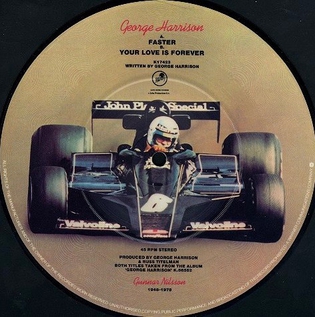
"Your Love Is Forever" is a song by English rock musician George Harrison from his 1979 album George Harrison. He wrote it as a guitar instrumental in an open tuning, before adding lyrics at the suggestion of his co-producer, Russ Titelman. The lyrics have an ambiguity typical of Harrison's work, in that the love he expresses is directed towards both a romantic partner and his God. In the United Kingdom, the song was also issued as the B-side of "Faster", on a charity single benefiting the cancer research project set up by the late Formula 1 driver Gunnar Nilsson.

"Soft Touch" is a song by English rock musician George Harrison from his 1979 album George Harrison. It was also issued as the B-side of the album's lead single, "Blow Away", in Britain and some other countries, while in markets such as North America, it was the B-side of the second single, "Love Comes to Everyone". Harrison wrote the song while in the Virgin Islands with his future wife, Olivia Arias, shortly before recording his 1976 album Thirty Three & ⅓. The song is a love song in which Harrison also conveys his wonder at the idyllic island setting.

"Save the World" is a song by English rock musician George Harrison, released as the final track of his 1981 album Somewhere in England. It was also the B-side of "Teardrops", which was the second single off the album. An environmental protest song, "Save the World" was Harrison's first composition to directly address topical issues such as the nuclear arms race, rainforest and wildlife devastation, and the ecologically irresponsible practices of corporate concerns. Musically, the song partly recalls the style of the comedy troupe Monty Python.
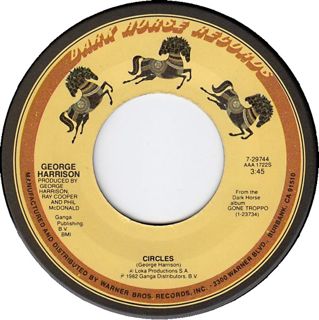
"Circles" is a song by English rock musician George Harrison, released as the final track of his 1982 album Gone Troppo. Harrison wrote the song in India in 1968 while he and the Beatles were studying Transcendental Meditation with Maharishi Mahesh Yogi. The theme of the lyrics is reincarnation. The composition reflects the cyclical aspect of human existence as, according to Hindu doctrine, the soul continues to pass from one life to the next. Although the Beatles never formally recorded it, "Circles" was among the demos the group made at Harrison's Esher home, Kinfauns, in May 1968, while considering material for their double album The Beatles.
"Ride Rajbun" is a song by English musician George Harrison. It was released in 1992 on the multi-artist charity album The Bunbury Tails, which was the soundtrack to the British animated television series of the same name. Harrison co-wrote the song's lyrics with Bunbury Tails creator David English. The eponymous Rajbun was a character in the series, one of a team of cricket-playing rabbits – in this case, from Bangalore in India. The composition is in the style of a nursery rhyme or children's song, while the all-Indian instrumentation on the recording recalls some of Harrison's compositions for the Beatles during 1966–68.
"Life Itself" is a song by English musician George Harrison from his 1981 album Somewhere in England. Harrison also included it on his 1989 greatest-hits compilation Best of Dark Horse. As a love song to God, the track served as the artist's most overtly religious musical statement since 1974. The lyrics offer praise to Christ, Vishnu, Jehovah and Buddha, thereby marking a return to the concept of a universal deity, regardless of religious demarcation, that Harrison had first espoused in his 1970 hit single "My Sweet Lord".

Songs by George Harrison is a book of song lyrics and commentary by English musician George Harrison, with illustrations by New Zealand artist Keith West. It was published in February 1988, in a limited run of 2500 copies, by Genesis Publications, and included an EP of rare or previously unreleased Harrison recordings. Intended as a luxury item, each copy was hand-bound and boxed, and available only by direct order through Genesis in England. The book contains the lyrics to 60 Harrison compositions, the themes of which West represents visually with watercolour paintings. Starting in 1985, Harrison and West worked on the project for two years, during which Harrison returned to music-making with his album Cloud Nine, after focusing on film production for much of the early 1980s. The book includes a foreword by his Cloud Nine co-producer, Jeff Lynne, and a written contribution from Elton John.
Songs by George Harrison 2 is a book of song lyrics and commentary by English musician George Harrison, with illustrations by Keith West and an accompanying EP of previously unreleased Harrison recordings. It was published in June 1992, in a limited run of 2500 copies, by Genesis Publications. As with Harrison and West's first volume, published in 1988, each copy was hand-bound and available only by direct order through Genesis in England.










